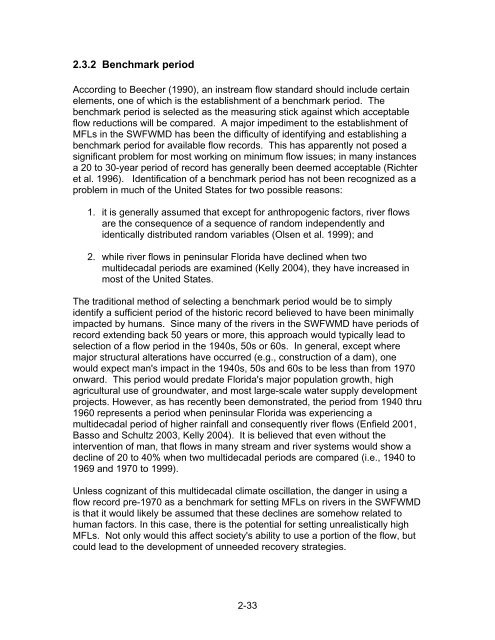Alafia River Minimum Flows and Levels - Southwest Florida Water ...
Alafia River Minimum Flows and Levels - Southwest Florida Water ...
Alafia River Minimum Flows and Levels - Southwest Florida Water ...
Create successful ePaper yourself
Turn your PDF publications into a flip-book with our unique Google optimized e-Paper software.
2.3.2 Benchmark period<br />
According to Beecher (1990), an instream flow st<strong>and</strong>ard should include certain<br />
elements, one of which is the establishment of a benchmark period. The<br />
benchmark period is selected as the measuring stick against which acceptable<br />
flow reductions will be compared. A major impediment to the establishment of<br />
MFLs in the SWFWMD has been the difficulty of identifying <strong>and</strong> establishing a<br />
benchmark period for available flow records. This has apparently not posed a<br />
significant problem for most working on minimum flow issues; in many instances<br />
a 20 to 30-year period of record has generally been deemed acceptable (Richter<br />
et al. 1996). Identification of a benchmark period has not been recognized as a<br />
problem in much of the United States for two possible reasons:<br />
1. it is generally assumed that except for anthropogenic factors, river flows<br />
are the consequence of a sequence of r<strong>and</strong>om independently <strong>and</strong><br />
identically distributed r<strong>and</strong>om variables (Olsen et al. 1999); <strong>and</strong><br />
2. while river flows in peninsular <strong>Florida</strong> have declined when two<br />
multidecadal periods are examined (Kelly 2004), they have increased in<br />
most of the United States.<br />
The traditional method of selecting a benchmark period would be to simply<br />
identify a sufficient period of the historic record believed to have been minimally<br />
impacted by humans. Since many of the rivers in the SWFWMD have periods of<br />
record extending back 50 years or more, this approach would typically lead to<br />
selection of a flow period in the 1940s, 50s or 60s. In general, except where<br />
major structural alterations have occurred (e.g., construction of a dam), one<br />
would expect man's impact in the 1940s, 50s <strong>and</strong> 60s to be less than from 1970<br />
onward. This period would predate <strong>Florida</strong>'s major population growth, high<br />
agricultural use of groundwater, <strong>and</strong> most large-scale water supply development<br />
projects. However, as has recently been demonstrated, the period from 1940 thru<br />
1960 represents a period when peninsular <strong>Florida</strong> was experiencing a<br />
multidecadal period of higher rainfall <strong>and</strong> consequently river flows (Enfield 2001,<br />
Basso <strong>and</strong> Schultz 2003, Kelly 2004). It is believed that even without the<br />
intervention of man, that flows in many stream <strong>and</strong> river systems would show a<br />
decline of 20 to 40% when two multidecadal periods are compared (i.e., 1940 to<br />
1969 <strong>and</strong> 1970 to 1999).<br />
Unless cognizant of this multidecadal climate oscillation, the danger in using a<br />
flow record pre-1970 as a benchmark for setting MFLs on rivers in the SWFWMD<br />
is that it would likely be assumed that these declines are somehow related to<br />
human factors. In this case, there is the potential for setting unrealistically high<br />
MFLs. Not only would this affect society's ability to use a portion of the flow, but<br />
could lead to the development of unneeded recovery strategies.<br />
2-33
















